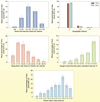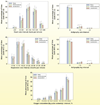Sedation in adults receiving mechanical ventilation: physiological and comfort outcomes
- PMID: 22549581
- PMCID: PMC3703630
- DOI: 10.4037/ajcc2012301
Sedation in adults receiving mechanical ventilation: physiological and comfort outcomes
Abstract
Objective: To describe the relationships among sedation, stability in physiological status, and comfort during a 24-hour period in patients receiving mechanical ventilation.
Methods: Data from 169 patients monitored continuously for 24 hours were recorded at least every 12 seconds, including sedation levels, physiological status (heart rate, respiratory rate, oxygen saturation by pulse oximetry), and comfort (movement of arms and legs as measured by actigraphy). Generalized linear mixed-effect models were used to estimate the distribution of time spent at various heart and respiratory rates and oxygen saturation and actigraphy intervals overall and as a function of level of sedation and to compare the percentage of time in these intervals between the sedation states.
Results: Patients were from various intensive care units: medical respiratory (52%), surgical trauma (35%), and cardiac surgery (13%). They spent 42% of the time in deep sedation, 38% in mild/moderate sedation, and 20% awake/alert. Distributions of physiological measures did not differ during levels of sedation (deep, mild/moderate, or awake/alert: heart rate, P = .44; respirations, P = .32; oxygen saturation, P = .51). Actigraphy findings differed with level of sedation (arm, P < .001; leg, P = .01), with less movement associated with greater levels of sedation, even though patients spent the vast majority of time with no arm movement or leg movement.
Conclusions: Level of sedation most likely does not affect the stability of physiological status but does have an effect on comfort.
Figures
References
-
- Wunsch H, Kress JP. A new era for sedation in ICU patients. JAMA. 2009;301:542–544. - PubMed
-
- Weinert CR, Calvin AD. Epidemiology of sedation and sedation adequacy for mechanically ventilated patients in a medical and surgical intensive care unit. Crit Care Med. 2007;35:393–401. - PubMed
-
- Sessler CN, Grap MJ, Brophy GM. Multidisciplinary management of sedation and analgesia in critical care. Semin Respir Crit Care Med. 2001;22:211–225. - PubMed
-
- Jacobi J, Fraser GL, Coursin DB, et al. Task Force of the American College of Critical Care Medicine (ACCM) of the Society of Critical Care Medicine (SCCM), American Society of Health-System Pharmacists (ASHP), American College of Chest Physicians. Clinical practice guidelines for the sustained use of sedatives and analgesics in the critically ill adult [published correction appears in Crit Care Med2002;30(3):726] Crit Care Med. 2002;30:119–141. - PubMed
-
- Sessler CN. Comfort and distress in the ICU: scope of the problem. Semin Respir Crit Care Med. 2001;22:111–114. - PubMed




